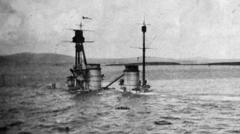What New Legal Protections Are Coming for Orkney's Shipwreck Sites?

Legal Protection for World War One Warships in Scapa Bay: A Historic Move
In a landmark decision, the Scottish government has announced legal protection for the historic warships of the German High Seas Fleet, which lie submerged in the waters of Scapa Bay, Orkney. This initiative aims to preserve the remnants of these vessels that were deliberately scuttled in 1919 by their crews, under the command of Admiral Ludwig von Reuter, who mistakenly believed peace negotiations had collapsed. This article delves into the significance of this protection, the historical context of the scuttling, and the implications for future exploration and preservation of marine heritage.
The Scuttling of the German Fleet: A Historical Overview
The scuttling of the German High Seas Fleet in Scapa Flow remains one of the most dramatic events in naval history. After World War I, the fleet was interned in Scapa Flow, a strategic body of water in Orkney, while negotiations for peace were underway. On June 21, 1919, amid misunderstandings regarding the status of the negotiations, Admiral von Reuter ordered the fleet to be sunk to prevent it from falling into enemy hands. As a result, 52 ships were sent to the seabed, creating a unique underwater archaeological site.
The Importance of Marine Protected Areas
The designation of a Marine Protected Area (MPA) around Scapa Bay signifies a monumental step in the conservation of marine heritage. The new MPA status not only recognizes the historical significance of the wrecks but also aims to safeguard them from further degradation. The Orkney Islands Council has long advocated for this protection, citing the vulnerability of these sites and the importance of preserving features that hold historical value.
What the Legal Protection Entails
With the new MPA designation, it will now be a criminal offense to remove items from the wreck sites in Scapa Bay. This is a significant shift from the previous policy, which allowed for the recovery of artifacts if registered. Over the years, many items, including ship bells, navigational equipment, and even musical instruments, have been removed and added to private collections or museums, often without sufficient consideration of their historical context.
Implications for Divers and Researchers
The newly established regulations will not only protect the German fleet wrecks but will also create a framework for responsible diving and research in the area. Prior to this, divers could explore the wrecks but were allowed to collect items, leading to concerns about the loss of historical context. The MPA status will now facilitate a "look but don't touch" approach, ensuring that future generations can explore and learn from these sunken treasures without compromising their integrity.
The Role of Orkney Islands Council
The Orkney Islands Council has been a driving force behind the push for MPA designation, recognizing the economic and cultural potential of these wreck sites. Council leader Heather Woodbridge emphasized that the wrecks are a significant heritage asset and attract divers and history enthusiasts from around the globe. This influx of visitors not only contributes to local tourism but also raises awareness about the importance of preserving maritime history.
Historic MPA Status for Other Wrecks
The protection extends beyond the German fleet. The Queen of Sweden wreck, which sank in 1745, will also receive MPA status. This vessel, part of the Swedish East India Company, is recognized as one of the best-preserved shipwrecks from that era. The significance of these protections reflects a broader commitment to preserving Scotland's maritime heritage for future generations.
The Future of Maritime Heritage in Scotland
The designation of MPAs for the wrecks in Scapa Bay and surrounding areas represents a progressive move towards the conservation of underwater heritage. The Scottish government, through its Energy Secretary Gillian Martin, has recognized the national value of these sites, ensuring that they are protected for both historical and educational purposes. This initiative is a step towards a more sustainable future where the richness of Scotland's underwater heritage can be appreciated without compromising its integrity.
Potential Challenges Ahead
While the MPA designation is a significant achievement, challenges remain in enforcing these protections. The vastness of the waters and the popularity of diving in the area could pose difficulties in monitoring and maintaining the integrity of the wreck sites. Continued collaboration between the government, local councils, and diving communities will be essential in ensuring that these areas are respected and preserved.
Engaging the Public in Maritime Heritage
Public engagement and education will play a crucial role in the success of the MPA initiatives in Scapa Bay. By fostering a deeper understanding of the historical significance of these wrecks, stakeholders can create a sense of stewardship among divers and visitors. Educational programs, guided dives, and interpretative materials can enrich the experience and highlight the importance of preserving Scotland’s maritime past.
FAQs
What is the significance of the German High Seas Fleet wrecks in Scapa Bay?
The German High Seas Fleet wrecks are significant as they represent a critical moment in naval history, reflecting the aftermath of World War I and the complexities of peace negotiations. They serve as an important archaeological site that provides insights into naval warfare and maritime heritage.
How will the new MPA status affect diving activities in the area?
The new MPA status will allow divers to explore the wrecks but will prohibit the removal of any artifacts. This "look but don't touch" policy is aimed at preserving the historical integrity of the wrecks while still allowing for recreational diving.
What types of artifacts have been recovered from the wrecks?
Over the years, various artifacts have been recovered from the wrecks, including ship bells, navigational equipment, personal items, and musical instruments. Many of these items are now part of private collections or museum exhibits.
What other wrecks are included in the MPA designation besides the German fleet?
Alongside the German fleet wrecks, the Queen of Sweden wreck, which sank in 1745, is also included in the MPA designation. This wreck is recognized for its historical importance and preservation.
How can the public engage with Scotland's maritime heritage?
The public can engage with Scotland's maritime heritage through educational programs, guided diving experiences, and by visiting local museums that showcase artifacts and stories from these historic wrecks.
As Scotland embraces this monumental move to protect its underwater heritage, the future of these historic wrecks looks promising. The commitment to preserving these sites not only honors the past but also enriches the cultural tapestry of the nation. How do you feel about the importance of preserving maritime history? #ScapaBay #MaritimeHeritage #UnderwaterArchaeology
Published: 2025-08-11 06:49:17 | Category: technology



